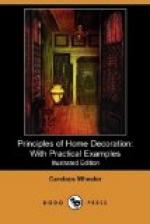A French kitchen, with its white-washed walls, its shining range and rows upon rows of gleaming copper-ware, is an attractive subject for a painter; and there is no reason why an American kitchen, in a house distinguished for beauty in all its family and semi-public rooms, should not also be beautiful in the rooms devoted to service. We can if we will make much even in a decorative way of our enamelled and aluminum kitchen-ware; we may hang it in graduated rows over the chimney-space—as the French cook parades her coppers—and arrange these necessary things with an eye to effect, while we secure perfect convenience of use. They are all pleasant of aspect if care and thought are devoted to their arrangement, and it is really of quite as much value to the family to have a charming and perfectly appointed kitchen, as to possess a beautiful and comfortable parlour or sitting-room.
Every detail should be considered from the double point of view of use and effect. If the curtains answer the two purposes of shading sunlight, or securing privacy at night, and of giving pleasing colour and contrast to the general tone of the interior, they perform a double function, each of of which is valuable.
If the chairs are chosen for strength and use, and are painted or stained to match the colour of the floor, they add to the satisfaction of the eye, as well as minister to the house service. A pursuance of this thought adds to the harmony of the house both in aspect and actual beauty of living. Of course in selecting such furnishings of the kitchen as chairs, one must bear in mind that even their legitimate use may include standing, as well as sitting upon them; that they may be made temporary resting-places for scrubbing pails, brushes, and other cleaning necessities, and therefore they must be made of painted wood; but this should not discourage the provision of a cane-seated rocking-chair for each servant, as a comfort for weary bones when the day’s work is over.
In establishments which include a servants’ dining-or sitting-room, these moderate luxuries are a thing of course, but in houses where at most but two maids are employed they are not always considered, although they certainly should be.
If a corner can be appropriated to evening leisure—where there is room for a small, brightly covered table, a lamp, a couple of rocking-chairs, work-baskets and a book or magazine, it answers in a small way to the family evening-room, where all gather for rest and comfort.
There is no reason why the wall space above it should not have its cabinet for photographs and the usually cherished prayer-book which maids love both to possess and display. Such possessions answer exactly to the bric-a-brac of the drawing-room; ministering to the same human instinct in its primitive form, and to the inherent enjoyment of the beautiful which is the line of demarcation between the tribes of animals and those of men.




